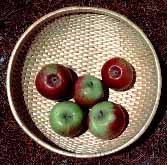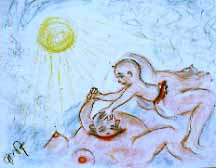 -
- 
One useful way to look at cesarean born people is to consider them to have a different native culture, native in the literal sense of having to do with birth, ie. natal. While not much work has been done with this concept, here are a few beginnings.
Cesarean Body Language - notes
by Jane English 1984
Apples and Bananas - a visual metaphor
- from Different Doorway - Jane English 1984
An Anthropological Perspective -
Jane English 1986
Cesarean Born and Vaginally Born Native
Cultures - Stanislav Grof 1988
See also the end of the article
by Mairead Ni Chonaola
Cesarean body language - notes by Jane English 1984
In trying to edit my journal writings for the book, Different Doorway, I find myself feeling frustrated. I can't find a way to feel good about cutting out much of the descriptions of the the body processes out of which the insights emerged. Just now I lay on the floor a while feeling all this, releasing painful places in my body -- places I'd been trying to edit out??!!
Then I remembered Tom Ednie speaking of the difficulty of using language to describe preverbal perinatal experiences. I am trying to write in a foreign language -- the words that have been formed by millennia of vaginally born people!!!
So I have to go back to body language to make sense -- literally
use the senses! I am trying to communicate to your body as well
as to your mind. You have to be willing to feel in your body what
I say, before you try to comprehend it with your mind. So read
slowly and pay attention to body.
Apples and Bananas - a visual metaphor
 -
- 
The comparison between caesarean birth and vaginal birth can teach us a great deal. Until about 100 years ago the vast majority of people were born vaginally. "Birth" meant "vaginal birth." A metaphor that I use for this is: If the only kind of fruit we knew were apples, we probably wouldn't have two words. We'd have one word that meant "fruit-apple." Then a banana appears, and our sense of what fruit is expands. It becomes more abstract and is not tied to the particulars of either form of fruit, apple or banana. During the whole history of the human race part of being human was the journey down the birth canal. Now, an increasingly large percentage of humans are born caesarean; they don't go down the birth canal. Bananas have joined the apples. We have an opportunity to become aware of a deeper level of humanness that transcends both kinds of birth learning, the patterns learned in caesarean birth and the patterns learned in vaginal birth. -- from Different Doorway, p.136
Anthropology and Cesarean Birth: Some Research Ideas - Jane English 1986
Introduction
During the inner journey that led to the writing and publication of Different Doorway; Adventures of a Caesarean Born, one of the perspectives that emerged for me was to consider caesarean born people, especially those born with no labor at all, as having a somewhat different native culture - native in the most literal sense of deriving from birth.
Our social, political and cultural forms are based on similarities among people. It seems likely that one of the deepest levels of similarity is the birth experience, labor and the trip down the birth canal. So in some way human social structures are probably based on vaginal birth learning. When cesarean born people are viewed as being from a different culture, one gets perspective both on that culture and on the culture of the vaginally born. This can lead to a more expansive view of human nature.
The idea of a cesarean native culture had more than intellectual significance for me; it brought healing, the release of negative judgments about some experienced differences between caesarean born people and most of the rest of society. Caesarean born people are a minority, but with about 20% of all births now being caesarean, we are a sizable minority that needs to be considered.
Psychological studies of caesareans are beginning to be made, but I feel that anthropology too has something to contribute. Anthropology looks at a larger social/cultural picture, and anthropology has a less pathology-oriented approach.
Some questions to consider
1) Is there a caesarean native culture? What are its symbols, myths, and world views? What does it contribute to the whole of humanity?
2) Do caesareans have problems in common with other minorities in a dominant culture?
3) Look at caesareans in different national cultures. What talents and what difficulties appear among caesareans in each culture. Get a view of caesarean native culture by seeing which national cultures they fit into most easily and which they have the most difficulty with.
4) Is a caesarean native culture just another culture or is it a "meta-culture" pointing by contrast to the meta-culture of the vaginally born, to commonalities that all national cultures share and have been considered simply as part of "being human"? eg. caesarean born kindergarten children have been observed to tend to "sit outside the circle". Do they do this in all national cultures?
Approaches to use
1) Traditional anthropological research - statistics and studies on, "Is there a caesarean native culture, and if so, what is it?"
2) Anthropology as an awareness practice. Awareness of differences allows one to transcend them. Use the tools of anthropology to create perspectives that caesareans, their families, and their associates might find healing and growth enhancing. Value the usefulness of concepts more than their statistical validity.
Doing the research
The people doing this research will most likely experience all the joys and trials of doing work in a new area, will have the satisfaction of helping people,and, especially if the researchers are themselves caesarean born, will find personal growth and healing. There is need for a broad perspective on the psychological, social, and spiritual aspects of life .
I am interested in playing a supporting and consulting role. My own desires are to share the excitement of exploration and to see some seed concepts that have been healing to me be amplified and passed on to others.
Acknowledgements
My thanks to Angeles Arrien for her support in keeping these ideas alive over the past few years, and to Lisa Faithorn for our discussions on Mt. Diablo that led to their clear formulation.
I enjoyed the drumming very much, I had never drummed this way before. There was a lot of one-pointed consciousness because you have to be sure you don't interfere with the other person... a different kind of attention than when you have a whole big drum like a Taos drum. So for me there was a lot of concentrated energy, then loosening, loosening and expanding, and I got into a very peaceful place towards the end. I was in an extremely expanded place after the powerful concentration.
Then these things related to caesarean... I came to things from the Kyoto transpersonal conference first. There was a presentation there that I thought was a breakthrough in the transpersonal movement. A Japanese Jungian analyst talked about the relationship between the Japanese mind and the Western Mind, business problems between Japan and the US. There were these negotiations and he was watching them from a Jungian point of view. He was trained in Switzerland and had quite a lot of insight into the Western psyche. He watched them (the negotiators) and said that they don't realize that they don't communicate at all. They are exchanging words, but each of them means something totally different because of the difference between the Japanese and Western psyches.
He gave a paper on this. The whole western culture has the idea of creation as coming from a powerful center, God, a powerhouse. Whereas the Oriental psyche has the creation out of a void; the center is empty. And this makes a lot of difference.
There was also a Zulu anthropologist and shaman who gave a talk on the difference between the African psyche and the Western psyche. There was also Andre Pantsalides(sp?) who was born in the Near East, in Syria, and living in Belgium. He gave a talk on the Arabic mind and the Western mind. Again there were incredible differences.
The reason I thought these talks were such an incredible contribution is that we can introduce these into the transpersonal movement and start connecting to some underlying basic humanity and see these (cultural psyches) as inflections rather than each one saying, "We are right, and those others are distorted world views that we'll study anthropologically."
 And when I saw Jane's slide of apples and
bananas I got a similar sense of the caesarean and the vaginally
born. Then this whole concept of contraction-and expansion became
what we can learn from each other. Somebody who was born vaginally
ends up with a lot of unnecessary constriction, limitations and
concerns, that then complicate their life. And a caesarean is
born with a lack of boundaries (a non-labor caesarean!)
And when I saw Jane's slide of apples and
bananas I got a similar sense of the caesarean and the vaginally
born. Then this whole concept of contraction-and expansion became
what we can learn from each other. Somebody who was born vaginally
ends up with a lot of unnecessary constriction, limitations and
concerns, that then complicate their life. And a caesarean is
born with a lack of boundaries (a non-labor caesarean!)
So the caesarean can teach the vaginally born that a certain degree of boundaries is unnecessary. And the vaginally born can show the caesarean the usefulness of limits. So in my drawing the vaginally born is pushing on the caesarean, showing them limits. And the caesarean is pulling the vaginally born free of the constriction.
Stanislav Grof, MD,PhD is a psychiatrist who for over thirty years has researched non-ordinary states of consciousness. One of the founders of transpersonal psychology, he is founder of Holotropic Breathwork, and is author of numerous books and articles.